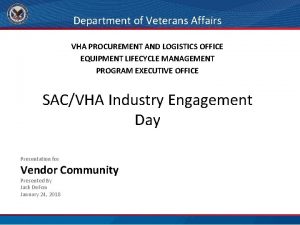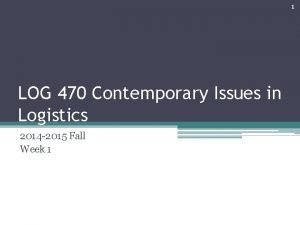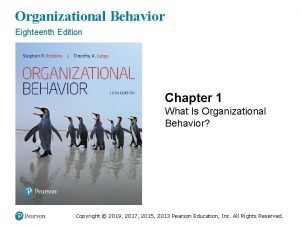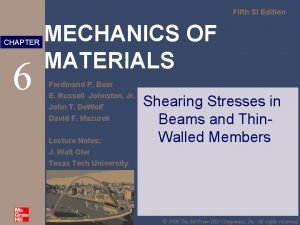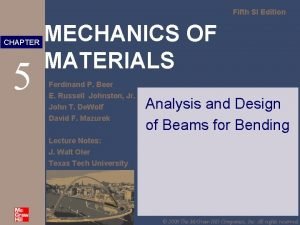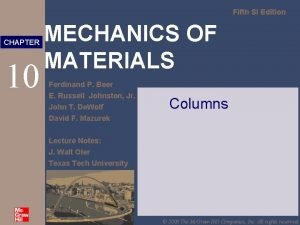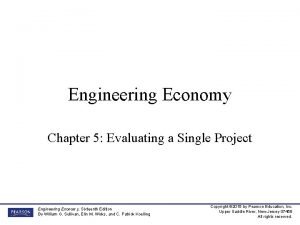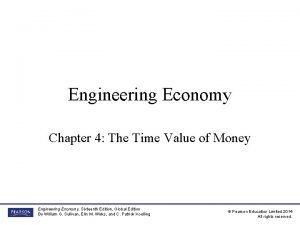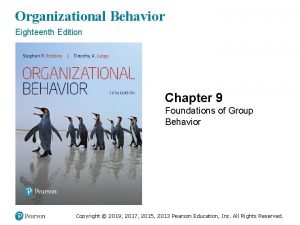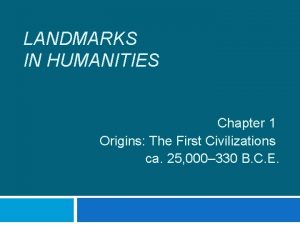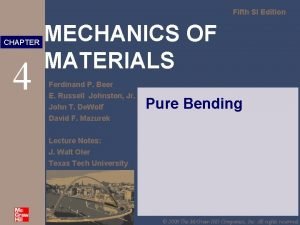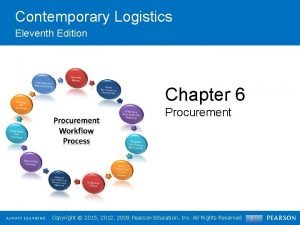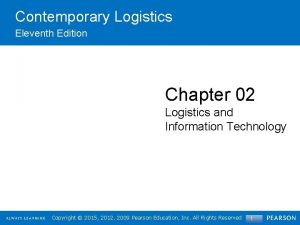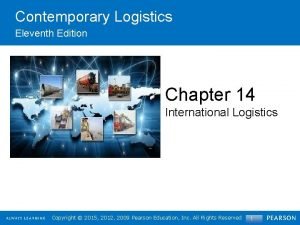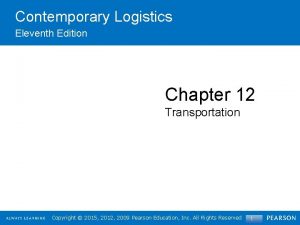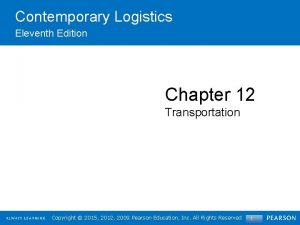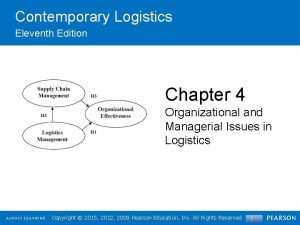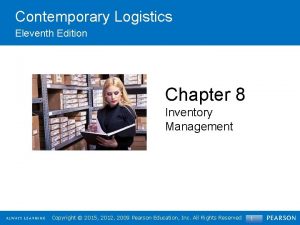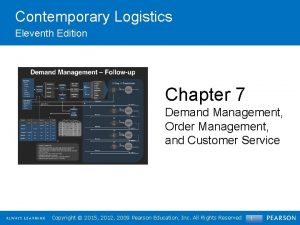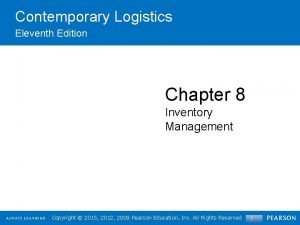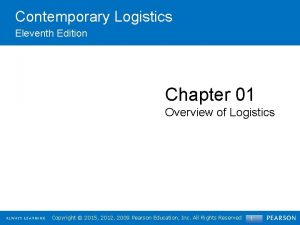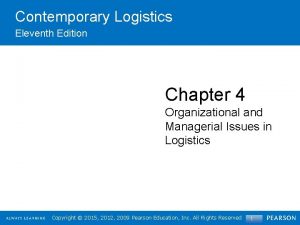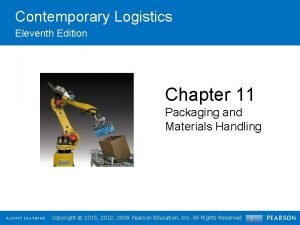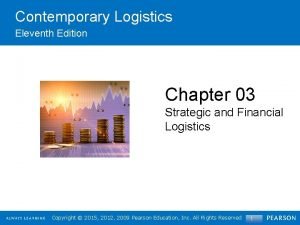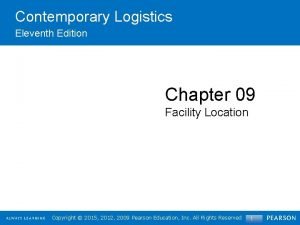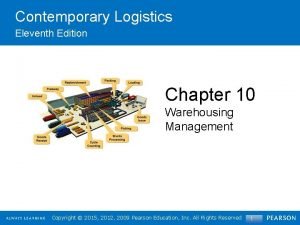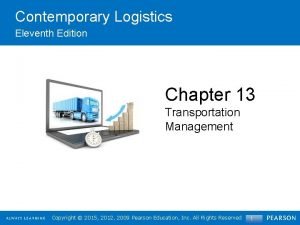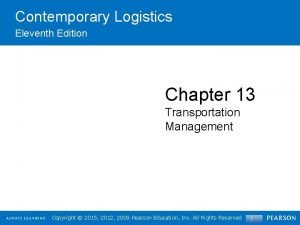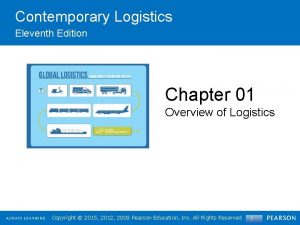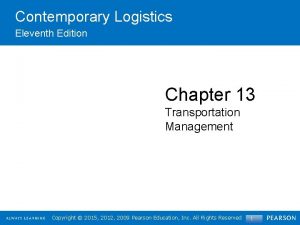Contemporary Logistics Eleventh Edition Chapter 6 Procurement Copyright






























- Slides: 30

Contemporary Logistics Eleventh Edition Chapter 6 Procurement Copyright©© 2015, 2012, 2009 Pearson. Education, Inc. All. Rights. Reserved Copyright 1

Learning Objectives • To understand the distinction between procurement, purchasing, and supply management • To examine procurement objectives • To learn about supplier selection and evaluation • To understand Kraljic’s Portfolio Matrix • To examine global procurement • To examine social and environmental aspects of sustainable procurement Copyright © 2015, 2012, 2009 Pearson Education, Inc. All Rights Reserved 2

Procurement Key Terms • Bribes • Procurement card (p-card) • Excess (surplus) materials • Scrap materials • Global procurement (sourcing) • Single sourcing • Investment recovery • Sustainable procurement • Kickbacks • Supplier audits • Kraljic’s Portfolio Matrix • Supplier development (reverse marketing) • Multiple sourcing • Supplier scorecards • Near-sourcing • Supply management • Obsolete materials • Total cost of ownership (TCO) • Procurement (purchasing) • Waste materials Copyright © 2015, 2012, 2009 Pearson Education, Inc. All Rights Reserved 3

Procurement (1 of 7) • Refers to the raw materials, component parts, and supplies bought from outside organizations to support a company’s operations • Procurement costs often range between 60%-80% of an organization’s revenues Copyright © 2015, 2012, 2009 Pearson Education, Inc. All Rights Reserved 4

Procurement (2 of 7) • Currently has a more strategic orientation in many organizations • Procurement manager may have responsibility for: • Reducing cycle times • Playing an integral role in product development • Generating additional revenues through collaboration with the marketing department 1 1 John Hyatt, “The Rise and Rise of Procurement, ” CFO 28, no. 4 (2012): 57– 59. Copyright © 2015, 2012, 2009 Pearson Education, Inc. All Rights Reserved 5

Procurement (3 of 7) • “Procurement” and “purchasing” are sometimes viewed as synonymous terms • Supply management is viewed as a relational exchange approach involving a limited number of suppliers. Copyright © 2015, 2012, 2009 Pearson Education, Inc. All Rights Reserved 6

Procurement (4 of 7) • Electronic commerce continues to bring many changes to the procurement discipline including • Electronic procurement • Procurement cards (p-cards) • Reverse auctions Copyright © 2015, 2012, 2009 Pearson Education, Inc. All Rights Reserved 7

Procurement (5 of 7) • Procurement cards (p-cards) • Similar to Visa and Master. Card, but used for an organization’s buying needs • Number of authorized employees is limited • Detailed statement is provided each month • Can implement control processes that • Measure usage • Identify procurement trends • Limit spending during a procurement cycle • Block unauthorized expenditures Copyright © 2015, 2012, 2009 Pearson Education, Inc. All Rights Reserved 8

Procurement (6 of 7) • Benefits of procurement cards (p-cards) • Reduction in the number of invoices • Firm will make one payment each month regardless of the number of p-card holders • Allows employees to make purchases in minutes vs. days • Generally allow suppliers to be paid in a more timely fashion Copyright © 2015, 2012, 2009 Pearson Education, Inc. All Rights Reserved 9

Procurement (7 of 7) • Challenges of procurement cards (expansion overseas) • Currency differences • Availability of technology • Difference in card acceptance • Cultural issues with the program Copyright © 2015, 2012, 2009 Pearson Education, Inc. All Rights Reserved 10

Procurement Objectives • Supporting organizational goals and objectives • Managing the purchasing process effectively and efficiently • Managing the supply base • Developing strong relationships with other functional groups • Supporting operational requirements Copyright © 2015, 2012, 2009 Pearson Education, Inc. All Rights Reserved 11

Supplier Selection and Evaluation (1 of 5) • One of procurement’s most important responsibilities • Involves stating an organization’s needs and determining how well various potential suppliers can fulfill these needs Copyright © 2015, 2012, 2009 Pearson Education, Inc. All Rights Reserved 12

Figure 6. 1 Supplier Selection Framework Copyright © 2015, 2012, 2009 Pearson Education, Inc. All Rights Reserved 13

Supplier Selection and Evaluation (2 of 5) • Steps to supplier selection and evaluation • Identify need for supply • Situation analysis • Identify possible suppliers • Select suppliers • Single source approach • Multiple sourcing approach • Evaluate decision • Process based approach • Performance based approach Copyright © 2015, 2012, 2009 Pearson Education, Inc. All Rights Reserved 14

Supplier Selection and Evaluation (3 of 5) • Evaluate decision • Process based approach • Is an assessment of the supplier’s service and/or production process (supplier audit) • Performance based approach • Is focused on the supplier’s actual performance on a variety of criteria including cost and quality • Many companies use supplier scorecards to report performance information Copyright © 2015, 2012, 2009 Pearson Education, Inc. All Rights Reserved 15

Supplier Selection and Evaluation (4 of 5) • Within the “situation analysis” step for supplier selection and evaluation, procurement managers must be continually aware of the supply and demand characteristics of the • Raw materials • Component parts • Purchased supplies Copyright © 2015, 2012, 2009 Pearson Education, Inc. All Rights Reserved 16

Supplier Selection and Evaluation (5 of 5) • Kraljic’s Portfolio Matrix 1 • Used to classify corporate purchases in terms of their importance and supply complexity • Goal is to minimize supply vulnerability and getting the most of the firm’s purchasing power 1 Peter Kraljic, “Purchasing Must Become Supply Management, ” Harvard Business Review 61, no. 5 (1983): 109– 117. Copyright © 2015, 2012, 2009 Pearson Education, Inc. All Rights Reserved 17

Procurement Portfolio Approach Figure 6. 2 Kralijic Portfolio Matrix Source: Peter Kraljic, “Purchasing Must Become Supply Management. ” Harvard Business Review 61 , no. 5 (1983): 109– 117. Copyright © 2015, 2012, 2009 Pearson Education, Inc. All Rights Reserved 18

Supplier Development (Reverse Marketing) (1 of 2) • Refers to aggressive procurement involvement not typically part of supplier selection • Can include: • Purchaser initiating contact with supplier • Purchaser establishing prices, terms and conditions, and other behaviors Copyright © 2015, 2012, 2009 Pearson Education, Inc. All Rights Reserved 19

Supplier Development (Reverse Marketing) (2 of 2) • Motivation to adopt supplier development include: • Numerous inefficiencies associated with suppliers initiating marketing efforts toward purchasers • Purchaser may be aware of important benefits which are unknown to the supplier • Compel suppliers to meet necessary requirements to achieve competitive advantage in the supply chain Copyright © 2015, 2012, 2009 Pearson Education, Inc. All Rights Reserved 20

Global Procurement (Sourcing) (1 of 3) • Refers to buying components and inputs anywhere in the world • Driven by: • Factor-input strategy (organization is seeking low-cost or high-quality) • Market access strategy (organization is sourcing in markets where it plans to do significant business) Copyright © 2015, 2012, 2009 Pearson Education, Inc. All Rights Reserved 21

Global Procurement (Sourcing) (2 of 3) • Components of Global Sourcing Development model: • Planning • Specification • Evaluation • Relationship management • Transportation and holding costs • Implementation • Monitoring and improving Copyright © 2015, 2012, 2009 Pearson Education, Inc. All Rights Reserved 22

Global Procurement (Sourcing) (3 of 3) • Challenges in establishing a successful global sourcing strategy include understanding hidden costs as supply bases are expanded • Examples of hidden costs: • Increased costs of dealing with suppliers outside the domestic market • Duty and tariff changes that occur over supply agreement life • Increased inventory-related costs associated with global supply chains • Rising levels of logistics cost volatility (e. g. ocean freight rates) Copyright © 2015, 2012, 2009 Pearson Education, Inc. All Rights Reserved 23

Sustainable Procurement • Refers to the integration of social and environmental considerations into all stages of the purchasing process • Goal is to minimize the impact of procurement activities on human health and the environment Copyright © 2015, 2012, 2009 Pearson Education, Inc. All Rights Reserved 24

Socially Responsible Procurement (1 of 2) • Consists of the following five dimensions: • Diversity • The Environment • Human Rights • Philanthropy • Safety Copyright © 2015, 2012, 2009 Pearson Education, Inc. All Rights Reserved 25

Socially Responsible Procurement (2 of 2) • Ethical considerations • “win at all costs” philosophy can exacerbate unethical behavior • Areas of ethical concern in procurement: • Gift giving and receiving • Bribes and kickbacks • Misuse of information • Improper methods of knowledge acquisition • Lying or misrepresentation of the truth • Product quality (lack of) • Misuse of company assets • Conflicts of interest Copyright © 2015, 2012, 2009 Pearson Education, Inc. All Rights Reserved 26

Investment Recovery (1 of 3) • Identifies opportunities to recover revenues or reduce costs associated with: • Scrap • Surplus • Obsolete • Waste materials • Often the responsibility of the procurement manager Copyright © 2015, 2012, 2009 Pearson Education, Inc. All Rights Reserved 27

Investment Recovery (2 of 3) • Can provide an organization the opportunity to simultaneously increase revenues (through cost reduction) while addressing selected environmental considerations Copyright © 2015, 2012, 2009 Pearson Education, Inc. All Rights Reserved 28

Investment Recovery (3 of 3) • Even the best managed organizations generate: • Excess (surplus) • Stock materials that exceed reasonable requirements • Obsolete • Materials not likely to ever be used again • Scrap • Materials that are no longer serviceable, have been discarded or are a by-product of the production process • Waste • Materials that have been spoiled, broken, or otherwise rendered unfit for further use or reclamation (have no economic value) Copyright © 2015, 2012, 2009 Pearson Education, Inc. All Rights Reserved 29

Copyright All rights reserved. No part of this publication may be reproduced, stored in a retrieval system, or transmitted, in any form or by any means, electronic, mechanical, photocopying, recording, or otherwise, without the prior written permission of the publisher. Printed in the United States of America. Copyright © 2015, 2012, 2009 Pearson Education, Inc. All Rights Reserved 30
 Management eleventh edition
Management eleventh edition Management stephen p robbins 11th edition
Management stephen p robbins 11th edition Management eleventh edition
Management eleventh edition Management eleventh edition
Management eleventh edition Vha procurement and logistics office
Vha procurement and logistics office Eleventh 5 year plan
Eleventh 5 year plan Eleventh 5 year plan
Eleventh 5 year plan Eleventh plan
Eleventh plan For his eleventh birthday elvis presley
For his eleventh birthday elvis presley Contemporary issues in logistics
Contemporary issues in logistics Mis chapter 6
Mis chapter 6 Using mis (10th edition)
Using mis (10th edition) Organizational behavior 18th edition chapter 1
Organizational behavior 18th edition chapter 1 Organic chemistry (3rd) edition chapter 1 problem 16s
Organic chemistry (3rd) edition chapter 1 problem 16s Mechanics of materials chapter 10 solutions
Mechanics of materials chapter 10 solutions Mechanics of materials chapter 7
Mechanics of materials chapter 7 Mechanics of materials chapter 6 solutions
Mechanics of materials chapter 6 solutions Chapter 5 mechanics of materials solutions
Chapter 5 mechanics of materials solutions Mechanics of materials 6th edition beer solution chapter 3
Mechanics of materials 6th edition beer solution chapter 3 Everything's an argument chapter 1
Everything's an argument chapter 1 Ifsta 7th edition chapter 6
Ifsta 7th edition chapter 6 Engineering economy 16th edition chapter 5 solutions
Engineering economy 16th edition chapter 5 solutions Deffered annuity
Deffered annuity Business essentials 12th edition chapter 1
Business essentials 12th edition chapter 1 Schachter singer theory
Schachter singer theory Prehospital emergency care 11th edition
Prehospital emergency care 11th edition Role requirements change in different situations
Role requirements change in different situations Organic chemistry david klein 3rd edition
Organic chemistry david klein 3rd edition Landmarks in humanities 5th edition chapter 1
Landmarks in humanities 5th edition chapter 1 Infants, children, and adolescents 8th edition
Infants, children, and adolescents 8th edition Mechanics of materials chapter 4
Mechanics of materials chapter 4




